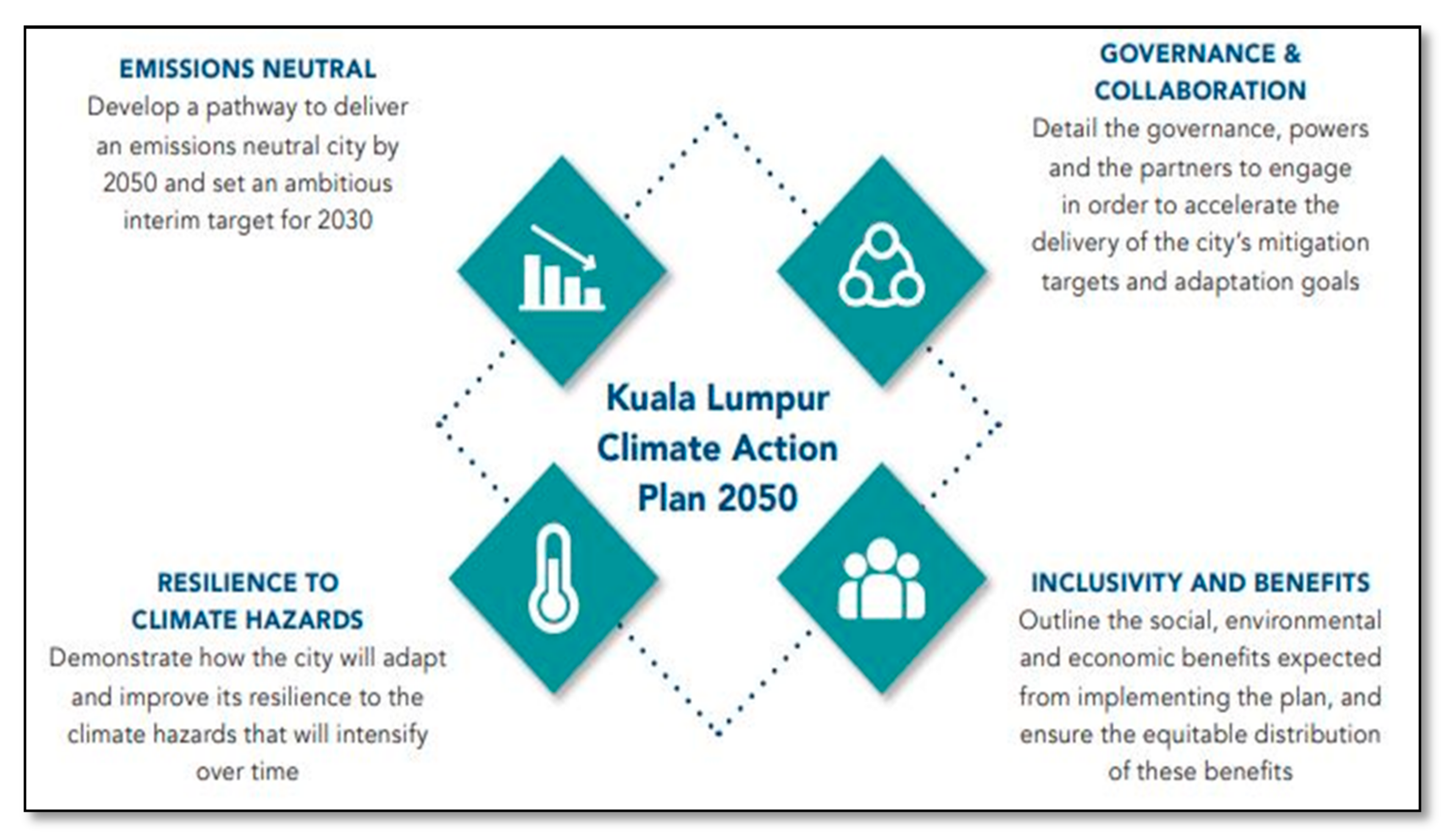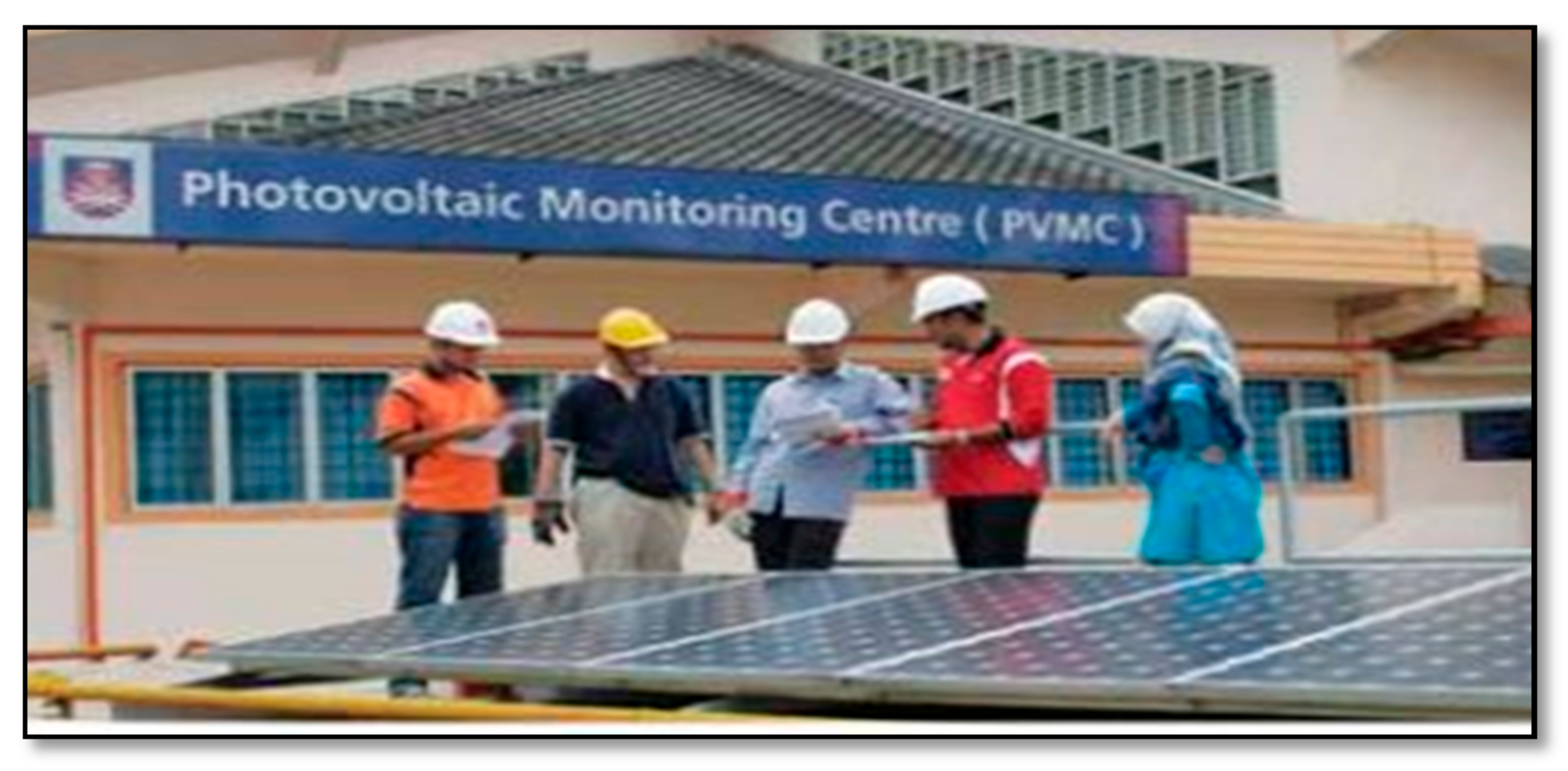You're using an outdated browser. Please upgrade to a modern browser for the best experience.
Please note this is a comparison between Version 2 by Peter Tang and Version 1 by NAJWA SYAHIRAH BINTI MOHAMED NOR IZAM.
Renewable energy was available in rural areas in the form of wind farms, solar plants, biomass plants and others. In urban contexts, particularly with the use of solar energy technologies called solar energy systems in buildings, such as solar thermal and photovoltaic (PV). The viewpoints on solar energy technologies for sustainable development is particular to emphasis on photovoltaic (PV), as well as the solar energy technology performance, in order to ascertain worldwide solar energy adoption trends.
- sustainable development
- green building
- renewable energy
- energy efficiency
- solar energy
- solar energy technologies
- solar photovoltaic
1. Introduction
The world is fast progressing toward a global agenda guided by the Sustainable Development Goals (SDGs). According to a study conducted by M. Stafford-Smith et al. (2016), nations convened in September 2015 in New York for the United Nations 2015 (UN2015) to commit to the Sustainable Development Goals (SDGs), which must be achieved by 2030. The Sustainable Development Goals (SDGs) were adopted by world leaders in New York at the United Nations. These 17 goals and 169 targets provide a strategy for all nations’ long-term development, focusing on economic growth, social inclusion, and environmental conservation. The focus has shifted away from agreeing on goals, and toward implementing and eventually attaining them. The world has concentrated rightly on achieving an integrated agenda through the SDGs, however inadequately accomplished in this initial iteration of such a transformative agenda [1]. By and large, fulfilling the SDGs’ targets would require a flexible and integrated global innovation system that actively connects regions throughout the world, connects research and society actors, and allows co-production, and transfer of locally relevant knowledge and technology. As a result, the endeavor has concentrated on integrating the substantive goals.
Renewable energy was available in rural areas in the form of wind farms, solar plants, biomass plants and others. In urban contexts, particularly with the use of solar energy technologies called solar energy systems in buildings, such as solar thermal and photovoltaic (PV). Some other studies by N. Sánchez-Pantoja, R. Vidal, and M. Carmen (2021) also highlighted in the early years, research into the utilization of solar energy in buildings was highly technical. The focus of attention was on optimizing the installation in terms of energy efficiency and economic costs. The challenge of establishing energy models was based only on renewable energy systems. Furthermore, programs focused on promoting the installation of renewable energies on an urban scale, as well as storage energy systems, are critical to effectively combating climate change, improving global energy performance in cities, and achieving more resilient cities. In this sense, terminology such as “sustainable communities,” “energy autonomy,” or “energy self-sufficiency” were already being used to talk about sustainable development as a whole, incorporating the technical, environment, social, economic and political challenges [2].
According to M.H. Shubbak’s (2019) research, the development of material components, production processes, and applications for both photovoltaic (PV) and Balance of System Technologies (BoS) is a significant research field in the modern day. The components of the BoS are critical for connecting, chemically protecting, and mechanically mounting the cells into panels, as well as electronically regulating their output levels for use, storage in batteries, or feeding into the utility grid. Additionally, the system incorporates testing and monitoring operations, as well as portable solar-powered gadgets [3]. Thus, whether centralized utility-scale or distributed, PV systems are composed of two distinct groupings of elements for solar cells and BoS, such as PV panels, electronics, and energy storage.
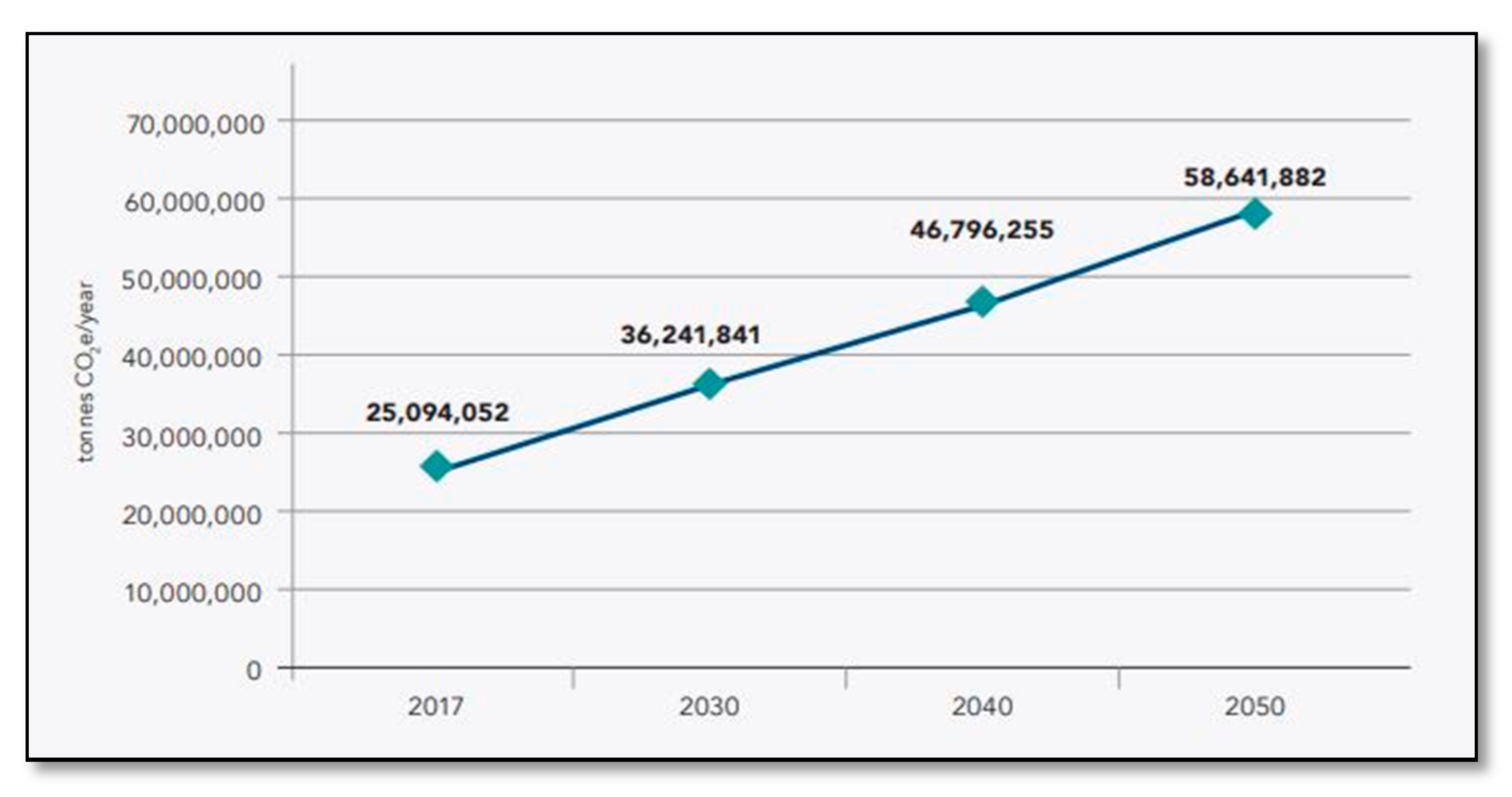
2. Environment and Health Barriers to Solar Energy Technologies
2.1. Climate Change
Research conducted by J. Nowotny et al. (2018), the production of energy has a significant impact on climate change. At the moment, the world community’s principal objective is to mitigate the adverse effects of climate change. A related critical objective is to examine ways to create energy in an environmentally sustainable manner. The process of photosynthesis, which resulted in the removal of carbon dioxide (CO2) from the atmosphere over hundreds of millions of years, culminated in the formation of carbon-rich fossil formations. Combustion of these deposits on a large scale releases unsustainable amounts of CO2 into the atmosphere, resulting in an amplified greenhouse effect and eventual climate change, with the potential for catastrophic alterations to the planet’s ecosystems. The fundamental environmental risk is that human activity will pollute and contaminate water, air, and soil. If this occurs, people’s access to safe drinking water, clean air, and food will be endangered [4]. As a result, it is becoming increasingly evident that mitigating human-caused climate change through the use of solar energy is important to protect the ecosystem. Renewable energy technologies have the potential to make a significant contribution to global sustainable development by supplying clean energy, to address issues such as food insecurity, poverty, and climate change. According to A. Shahsavari et al. (2018), global climate policy’s primary strategies are greenhouse gas (GHG) emission reduction and climate change mitigation. Increased use of renewable energy sources is a critical component of achieving these goals. Solar energy technologies, such as solar photovoltaic (PV), hold enormous promise for reducing energy-related emissions and thus contributing to climate change mitigation. If global average temperatures continue to rise by more than two degrees Celsius per year, it is predicted that natural disasters will become more frequent, with hotter and longer droughts, agricultural failure, and mass extinctions [5]. In fact, climate change affects natural ecosystems as well as numerous human–environment systems. Moreover, J. Cronin (2018) analyzed that the climate change adaptation potential is discussed in a variety of ways. Climate change mitigation is highly dependent on a significant decarbonization of the energy system. Through long-term changes in climate parameters, variability, and extreme weather events, climate change has an effect on energy system components. As a result of climate change, cloud cover is anticipated to decrease in low-to-mid latitude regions. Importantly, climate change is projected to have a ripple impact throughout the energy sector [6]. M. A. Hannan et al. (2018) also point to how Malaysia is currently making a variety of steps as a signatory of the United Nations Framework Convention on Climate Change to adhere to the policy in order to address the challenges of reducing excessive reliance on fossil fuels, reducing carbon levels, and achieving sustainable national development. In Malaysia, climate change has an impact on our daily life and has the potential to reduce energy related environmental impacts, such as GHG emissions from energy usage per unit of GHG [7]. Besides, according to the Kuala Lumpur Climate Action Plan 2050 (2021), Kuala Lumpur City Hall (DBKL) is committed to making this Climate Action Plan a success, and it is confident in its implementation strategy to create a Kuala Lumpur that is climate resilient and carbon neutral for all by 2050 [8]. The development of the Kuala Lumpur Climate Action Plan 2050 (KLCAP2050) was undertaken to address and fulfil four main components as shown in Figure 1. Lastly, Sustainable Energy Development Authority (SEDA) Malaysia discussed grid-connected solar photovoltaic (PV) systems, as well as the design of GCPV systems that are appropriate for Malaysia’s regional climate. SEDA (2020) also discussed Malaysian grid connection requirements and standards, as well as PV inverter systems and related equipment that are suitable for Malaysian climate [9]. The training institutions located in Shah Alam, Selangor Malaysia at Selangor Human Resource Development Center (SHRDC) and Photovoltaic Monitoring Centre (PVMC), Universiti Teknologi MARA (UiTM) are shown in Figure 2.2.2. Greenhouse Gas (GHG) and Carbon Dioxide (CO
2
) Emissions
The use of conventional fuels has resulted in a rapid increase in carbon dioxide (CO2) emissions in the developing world, according to a study conducted by A. Shahsavari et al. (2018). Conventional energy generation is now the leading source of GHG emissions globally, particularly in developing countries, accounting for about 40 percent of global primary energy and approximately 40 percent of global electricity output. As a result, fossil fuel power plants emit massive amounts of harmful pollutants into the atmosphere, including carbon dioxide (CO2), nitrogen oxides (NO2), and sulfur dioxide (SO2). CO2 emissions growth in developing economies is primarily due to a significant increase in the use of conventional fuels, such as coal, oil, and natural gas, to meet rapidly growing energy demand [5]. Therefore, solar energy is the best solution to energy poverty, and it can provide excellent opportunities for reducing GHG emissions and indoor air pollution by replacing kerosene for lighting and firewood for cooking. Global demand for energy produced by fossil fuels is a significant factor in the upward trend in GHG emissions and air pollution. According to S. Diwania et al. (2020), the solar PV has the advantages of increased efficiency and pollution free energy. Thus, solar PV installed capacity is increasing on a daily basis around the world [10]. Besides, research conducted by M.A. Hannan et al. (2018) into Malaysia’s energy mix found natural gas and coal are the leading sources of GHG emissions, followed by hydropower. Oil reserves are depleting at an alarming rate, and it is no longer regarded a sustainable source of electricity generation. Malaysia is impacted by the hazardous emissions generated by fossil fuel combustion, which contributes to global warming. As a result, the use of fossil fuels is likely to contribute to the release of greenhouse gases (GHG) during their combustion, aggravating the climate change problem [7]. The majority of Ghana’s rural villages, solar-powered systems and solar PV have been found by a study of A.A. Adenle (2019) to mitigate the carbon footprint of kerosene lights and firewood. According to an examination of survey data, South Africa uses solar energy technologies to reduce carbon emissions at a higher rate than Ghana and Kenya. Indeed, solar energy is a cost-effective method of generating electricity from solar radiation that has a minimal carbon footprint and causes no harm to the environment [11]. According to the survey conducted by M.R.M. Cruz et al. (2018), the European Union (EU) has set a target of reducing GHG emissions by 80–95 percent by 2050 relative to 1990 levels. This is only achievable with the combination of “green” energy technologies, primarily wind and solar. Wind and solar energy, in particular, are expected to provide half of the electricity in the EU by 2050. The demand for more “carbon-free” energy resources is increasing dramatically [12]. According to the Kuala Lumpur Climate Action Plan 2050 (2021), Kuala Lumpur’s annual carbon footprint was estimated to be 25 million metric tons in 2017. Transportation accounted for the most emissions, accounting for 56 percent of total emissions in the city. The GHG Emissions Inventory is a critical tool for quantifying and estimating carbon emissions, as well as tracking, reporting and evaluating a city’s progress on climate action. An updated inventory can notify Kuala Lumpur City Hall (DBKL), Malaysia, about the extent to which climate change mitigation initiatives and actions have resulted in actual GHG reductions or their equivalent in carbon emission reductions over time [8]. Meanwhile, without significant action by DBKL, it is estimated that Kuala Lumpur’s carbon emissions will more than double to 2.3 times their 2017 levels by 2050, as presented in Figure 3.
Figure 3.
Emissions forecasts from 2017 up to 2050 undertaken by DBKL
[8]
.
3. Sustainability of Solar Photovoltaics (PV)
3.1. Solar PV Sustainable Development
Sustainable development needs the preservation of natural capital, of which the regulations provide for renewable natural capital. H.E. Daly (2017) discusses two clear concepts of sustainable development that apply to the management of renewable resources. At the beginning, harvest rates should equal regeneration rates, which is referred to as sustained yield. Natural capital must be understood as regenerative and assimilative capacities, and failure to maintain these capacities must be viewed as capital consumption, which is not sustainable. Natural and man-made capital can be maintained at a variety of levels. Second, waste emission rates should be proportional to the inherent assimilation capacity of the ecosystems into which wastes are released. Natural capital is complementary to artificial capital as a source of raw materials and energy. Apart from that, natural capital’s capacity to absorb waste products complements the artificial capital that generates those wastes. In a nutshell, growth is the quantitative expansion of physical scale, whereas development is the qualitative expansion or unfolding of potentialities. Quantitative expansion in populations of both people and goods must eventually come to an end, but qualitative progress can continue under a sustainable development regime [13].
An experiment conducted by A.A. Bayod-Rujula (2019) presented how the PV conversion is based on the PV effect which is the conversion of light energy from the sun into electrical energy, as shown in Figure 4. PV cells are sun-exposed diodes with a wide surface area. An n-type layer is connected to a p-type layer to form a diode. The junction is the area where the two layers meet. Each region contains moving particles with different charges. Meanwhile, solar cells which are made of semiconductor materials and have an artificially created constant electric field through a p-n junction are used to carry out this conversion [14].
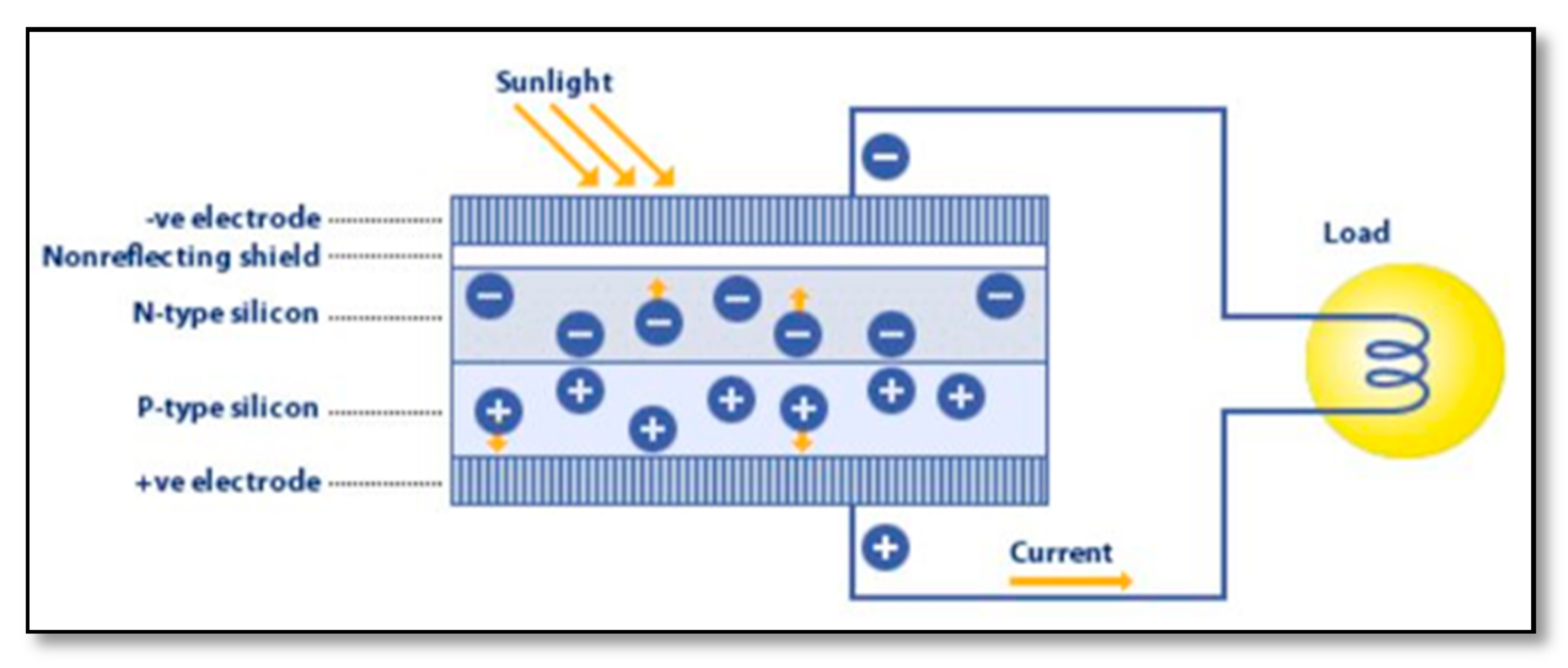

Figure 4.
Conversion of sunlight into electricity
[15]
.
According to P.J. Ribeyron (2017), PV crystalline silicon dominates the solar cell market (c-Si). Silicon has a number of significant advantages, including its widespread availability, nontoxicity, and theoretically high efficiency limit. Furthermore, electron hole pairs are formed by photon absorption within the silicon bulk, particularly in the front half of the cell, but the carriers must traverse the entire thickness of the silicon to reach the solar cell’s back contacts. The majority of sophisticated processes and materials originated in the microelectronics sector, and there were only a few photovoltaic research and development laboratories. Today, as a result of ongoing research and development focused on photovoltaic (PV) technology, silicon meets these stringent standards while balancing high bulk material quality and low cost [16].
B. Sorensen discussed the differences in the substrates, glass cover materials, and films used in various types of solar panels (2020). Solar equipment decommissioning and dismantling are expected to follow recycling and reuse trends seen in the building sector more broadly, with the building industry likely serving as a forerunner. Three types of electronic circuits are relevant to photovoltaic technology: junction boxes, charge controllers, and inverters. Additionally, in some locations, dust cleaning of solar panel surfaces may be required, and electronic control equipment, such as inverters, if not adequately protected, may generate radio-frequency disturbances. Hence, cleaning methods for PV panels, such as sand, dust, and snow removal robots and techniques, are required [17].
Research reported by W.C. Sinke (2019) showed that PV conversion can be accomplished using a variety of materials, device technologies, and architectural designs that are at varying stages of technical and economic maturity. Consider the following examples: Building-Integrated Photovoltaic (BIPV), Infrastructure-Integrated Photovoltaic (I2PV), Floating Photovoltaic (PV) systems, Ground-Based Photovoltaic (PV) Power Plants, and Vehicle-Integrated Photovoltaic (VIPV). The field of photovoltaics is undergoing rapid change, and the growing interest among engineers, scientists, and business leaders has resulted in an avalanche of literature attempting to keep abreast of the latest developments. It has made significant strides in the last decade in terms of deployment scale, cost reduction, and performance enhancement [18]. Thus, solar PV energy is predicted to play a significant role in the worldwide sustainable development energy system of the future.
3.2. Comparison of the Efficiency of Solar Photovoltaics (PV) to Other Renewable Energy (RE)
The research conducted by K.H. Solangi et al. (2011) and M.D. Madvar et al. (2018) showed that solar energy sources are available that are some of the most environmentally friendly and sustainable renewable energy sources today [19][20]. Renewable Energy (RE) is the best promising alternatives to fossil fuel energy. This energy is non-polluting and has a minimal environmental impact. It is not only an RE source, but it has also emerged as a viable alternative to big transformational technology. Its development helps to reduce global warming and greenhouse gas (GHG) emissions. Solar energy also can be used to generate direct electricity by extracting its thermal content or by applying photovoltaic (PV) cells to generate direct power [20]. Thus, solar energy has become one of the most popular RE sources due to its accessibility.
K.H. Solangi et al. (2011) highlighted the different countries that have developed solar energy strategies in order to reduce their consumption of fossil fuels and increase domestic solar energy consumption. Furthermore, to overcome the harmful environmental consequences and other issues associated with fossil fuels, several countries have been pushed to investigate and switch to environmentally friendly RE sources in order to satisfy rising energy demand [19]. Solar energy, as with other renewable energy sources, is a promising and readily available source of energy for resolving the long-term energy crisis, as N. Kannan and D. Vakeesan concluded (2016). The world’s energy demand is increasing rapidly as a result of population growth and technological advancements. As a result, it is critical to choose a stable, cost-effective, and eternal RE source for future energy demand. Nonetheless, it is due to the enormous demand for energy that the solar sector is steadily growing throughout the world, despite the fact that the primary energy source, fossil fuel, is finite and alternative energy sources are prohibitively expensive [21].
In the face of pressing issues, such as climate change and fossil fuel depletion, renewable energy sources are viewed as a clean and sustainable alternative. Through a large number of scientific publications and patents, photovoltaic technologies have developed into a significant field of research and development. Solar cells are the fundamental building block and primary component of photovoltaic systems. A solar cell is an electrical device that converts the energy contained in photons directly into direct current (DC) electricity via a chemical or physical process known as the photovoltaic effect. Photons with energy greater than the band gap of the cell material are absorbed, resulting in the excitation of charge carriers and thus in the generation of electric current and voltage. The conversion efficiency of a photovoltaic cell is defined as the percentage of incident light power that is converted to electrical energy under standard conditions [3]. Besides, according to K. Sopian et al. (2017), since its inception, the solar cell of photovoltaic (c-Si) technology has been recognized as the only long-term sustainable, environmentally friendly, and economically viable renewable energy source to replace fossil fuels. The primary driver of Si photovoltaic industry development has been cost reduction in order to compete with fossil fuels. Despite its rapid maturation, the crystalline Si photovoltaic field continues to be rich in novel device concepts and optical enhancement techniques [22].
Domestic and local renewable energy sources, such as domestic and local natural resources, are critical components of government energy policies. Malaysia’s energy policy which includes energy generation, supply and consumption is defined by the Malaysian government. Research conducted by M.A. Hannan et al. (2018) notes how Malaysia’s government is currently attempting to increase RE production. The energy sector is regulated by the Department of Electricity and Gas Supply. Besides this, the energy suppliers, service industries, Research and Development (R&D) institutions and customers are among the other stakeholders. Petroliam Nasional Berhad (PETRONAS) and Tenaga Nasional Berhad (TNB) are government-owned companies that dominate Malaysia’s energy market. In summary, regarding to Malaysian energy policies, these energy indicators are intended to encourage sustainable development [7].
G. Raina and S. Sinha (2019) informed that the high temperatures and mismatches in output from individual panels in a PV array frequently result in the formation of hotspots, which degrade the solar PV plant’s efficiency. These hotspots cause severe degeneration of the PV panel over time, raising maintenance and repair costs. PV module developers must conduct quality checks to avoid the establishment of hotspots. For the producer to increase the quality and lifetime of the PV modules, standards must be established [23]. According to SEDA (2020), PV Monitoring System (PVMS) is a project that utilizes the National PV Monitoring & Performance Database to monitor the performance and reliability of selected grid-connected solar photovoltaic (PV) systems. The Akaun Amanah Industri Bekalan Elektrik (AAIBE) and the Malaysian Electricity Supply Industries Trust Account are funding this program (MESITA). To begin, 148 grid-connected solar photovoltaic (PV) installations in Malaysia with a capacity of up to 1MW are being monitored in real time. Hence, subscriptions are required to access data and system performance analyses. In the future, the database will serve as a guide for developing national energy policies and for this programmed [9].
Lastly, M. Vaka et al. (2020) argued that the government launched a number of new initiatives and plans in response to the solar energy potential and, more broadly, renewable energy. Net Energy Metering (NEM), Feed-In Tariffs (FIT), Large-Scale Solar (LSS), Consumption (SELCO), and Renewable Energy (RE) incentives are just a few examples of programs aimed at reducing bills and fiscal burdens in the pursuit of a carbon-free environment. Malaysia’s government is concentrating its efforts on renewable energy and energy efficiency in order to reduce electricity bills and carbon dioxide (CO2) emissions. Indeed, Malaysian RE is a supporter of the ministry’s solar photovoltaic (PV) initiative to capture excess energy via the Net Energy Metering (NEM) program [24]. The Malaysian government has taken these initiatives and implemented numerous different programs to promote renewable and clean energy using the different technologies indicated in Figure 5.
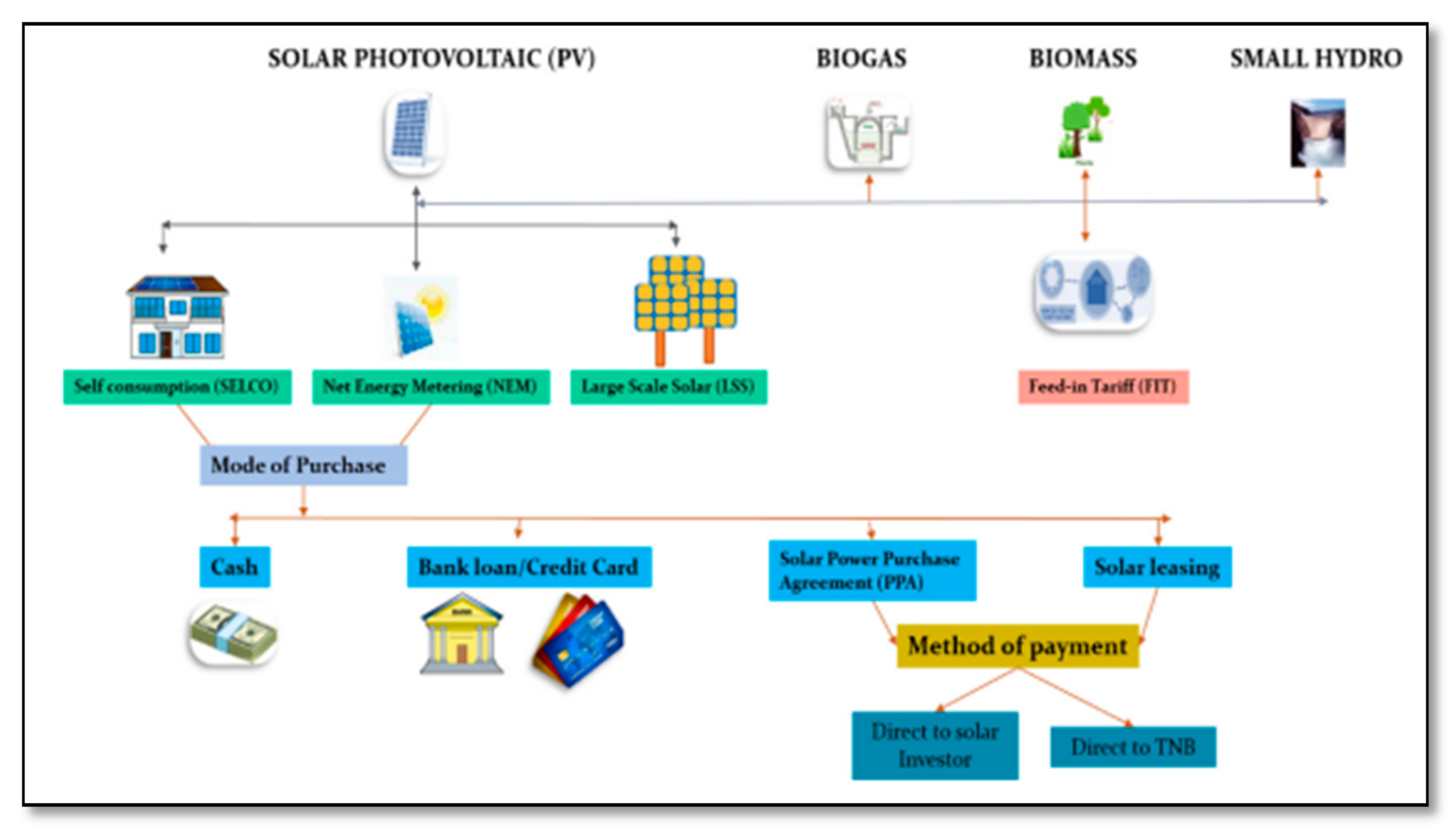

Figure 5.
Implementation of program using different technologies to improve Renewable Energy
[24]
.
References
- Stafford-Smith, M.; Griggs, D.; Gaffney, O.; Ullah, F.; Reyers, B.; Kanie, N.; Stigson, B.; Shrivastava, P.; Leach, M.; O’Connell, D. Sustainability Science and Implementing the Sustainable Development Goals Integration: The key to implementing the Sustainable Development Goals. Sustain. Sci. 2017, 12, 911–919.
- Sánchez-Pantoja, N.; Vidal, R.; Carmen, M. EU-Funded Projects with Actual Implementation of Renewable Energies in Cities. Analysis of Their Concern for Aesthetic Impact. Energies 2021, 14, 1627.
- Shubbak, M.H. Advances in solar photovoltaics: Technology review and patent trends. Renew. Sustain. Energy Rev. 2019, 115, 109383.
- Nowotny, J.; Dodson, J.; Fiechter, S.; Gür, T.M.; Kennedy, B.; Macyk, W.; Bak, T.; Sigmund, W.; Yamawaki, M.; Rahman, K.A. Towards global sustainability: Education on environmentally clean energy technologies. Renew. Sustain. Energy Rev. 2018, 81, 2541–2551.
- Shahsavari, A.; Akbari, M. Potential of solar energy in developing countries for reducing energy-related emissions. Renew. Sustain. Energy Rev. 2018, 90, 275–291.
- Cronin, J.; Anandarajah, G.; Dessens, O. Climate change impacts on the energy system: A review of trends and gaps. Clim. Chang. 2018, 151, 79–93.
- Hannan, M.A.; Begum, R.A.; Abdolrasol, M.G.; Lipu, H.; Mohamed, A.; Rashid, M.M. Review of baseline studies on energy policies and indicators in Malaysia for future sustainable energy development. Renew. Sustain. Energy Rev. 2018, 94, 551–564.
- Kuala Lumpur Climate Action Plan 2050. 2021. Available online: https://www.dbkl.gov.my/ (accessed on 26 July 2021).
- Hijau Setiajaya Sdn Bhd. Sustainable Energy Malaysia|Volume 4 Issue 10 1—SEDA; Hijau Setiajaya Sdn Bhd: Kuala Lumpur, Malaysia, 2020; pp. 1–56.
- Diwania, S.; Agrawal, S.; Siddiqui, A.S.; Singh, S. Photovoltaic–thermal (PV/T) technology: A comprehensive review on applications and its advancement. Int. J. Energy Environ. Eng. 2020, 11, 33–54.
- Adenle, A.A. Assessment of solar energy technologies in Africa-opportunities and challenges in meeting the 2030 agenda and sustainable development goals. Energy Policy 2020, 137, 111180.
- Cruz, M.R.M.; Fitiwi, D.Z.; Santos, S.F.; Catalão, J.P.S. A comprehensive survey of flexibility options for supporting the low-carbon energy future. Renew. Sustain. Energy Rev. 2018, 97, 338–353.
- Daly, H.E. Toward some operational principles of sustainable development. In The Economics of Sustainability; Taylor and Francis: London, UK, 2017; pp. 97–102.
- Bayod-Rújula, A.A. Solar photovoltaics (PV). In Solar Hydrogen Production; Elsevier: Amsterdam, The Netherlands, 2019; pp. 237–295.
- Solar Power as Renewable Energy for Home Systems in Bangladesh. 2014. Available online: https://www.researchgate.net/publication/271647041_Solar_Power_as_Renewable_Energy_for_Home_Systems_in_Bangladesh (accessed on 31 July 2021).
- Ribeyron, P.J. Crystalline silicon solar cells: Better than ever. Nat. Energy 2017, 2, 17067.
- Sørensen, B. Life-Cycle Analysis of Present and Future Si-Based Solar Cells. In Renewable Energy; Routledge: Wien, Austria, 2020; pp. 182–188.
- Sinke, W.C. Development of photovoltaic technologies for global impact. Renew. Energy 2019, 138, 911–914.
- Solangi, K.H.; Islam, M.R.; Saidur, R.; Rahim, N.A.; Fayaz, H. A review on global solar energy policy. Renew. Sustain. Energy Rev. 2011, 15, 2149–2163.
- Madvar, M.D.; Nazari, M.A.; Arjmand, J.T.; Aslani, A.; Ghasempour, R.; Ahmadi, M.H. Analysis of stakeholder roles and the challenges of solar energy utilization in Iran. Int. J. Low-Carbon Technol. 2018, 13, 438–451.
- Kannan, N.; Vakeesan, D. Solar energy for future world:-A review. Renew. Sustain. Energy Rev. 2016, 62, 1092–1105.
- Sopian, K.; Cheow, S.L.; Zaidi, S.H. An overview of crystalline silicon solar cell technology: Past, present, and future. In AIP Conference Proceedings; AIP Publishing LLC: Bangi, Selangor, Malaysia, 2017; Volume 1877, p. 20004.
- Raina, G.; Sinha, S. Outlook on the Indian scenario of solar energy strategies: Policies and challenges. Energy Strateg. Rev. 2019, 24, 331–341.
- Vaka, M.; Walvekar, R.; Rasheed, A.K.; Khalid, M. A review on Malaysia’s solar energy pathway towards carbon-neutral Malaysia beyond COVID’19 pandemic. J. Clean. Prod. 2020, 273, 122834.
More

